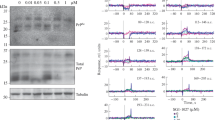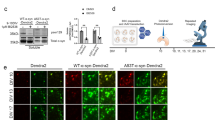Abstract
Prion diseases are fatal transmissible neurodegenerative disorders affecting humans and various mammals. In spite of intensive efforts, there is no effective cure or treatment for prion diseases. Cellular forms of prion protein (PrPC) is essential for propagation of abnormal isoforms of prion protein (PrPSc) and pathogenesis. The effect of an artificial dual microRNA (DmiR) on PrPC suppression and resultant inhibition of prion replication was determined using prion-infectible cell cultures: differentiated C2C12 culture and primary mixed neuronal and glial cells culture (MNGC). Processing of DmiR by prion-susceptible myotubes, but not by reserve cells, in differentiated C2C12 culture slowed prion replication, implying an importance of cell type-specific PrPC targeting. In MNGC, reduction of PrPC with DmiR was effective for suppressing prion replication. MNGC lentivirally transduced with non-targeting control miRNAs (scrambled) reduced prion replication at a level similar to that with a synthetic analogue of viral RNA, poly I:C. The results suggest that a synergistic combination of the immunostimulatory RNA duplexes (miRNA) and PrPC silencing with DmiR might augment a therapeutic potential of RNA interference.







Similar content being viewed by others
References
Colby DW, Prusiner SB (2011) Prions. Cold Spring Harb Perspect Biol 3(1):a006833. doi:10.1101/cshperspect.a006833
Collinge J, Clarke AR (2007) A general model of prion strains and their pathogenicity. Science 318(5852):930–936. doi:10.1126/science.1138718
Bessen RA, Marsh RF (1992) Biochemical and physical properties of the prion protein from two strains of the transmissible mink encephalopathy agent. J Virol 66(4):2096–2101
Bruce ME, McConnell I, Fraser H, Dickinson AG (1991) The disease characteristics of different strains of scrapie in Sinc congenic mouse lines: Implications for the nature of the agent and host control of pathogenesis. J Gen Virol 72(Pt 3):595–603. doi:10.1099/0022-1317-72-3-595
Safar J, Wille H, Itri V, Groth D, Serban H, Torchia M, Cohen FE, Prusiner SB (1998) Eight prion strains have PrP(Sc) molecules with different conformations. Nat Med 4(10):1157–1165. doi:10.1038/2654
Mallucci G, Collinge J (2005) Rational targeting for prion therapeutics. Nat Rev Neurosci 6(1):23–34. doi:10.1038/nrn1584
Aguzzi A, Sigurdson C, Heikenwaelder M (2008) Molecular mechanisms of prion pathogenesis. Annu Rev Pathol 3:11–40. doi:10.1146/annurev.pathmechdis.3.121806.154326
Bueler H, Aguzzi A, Sailer A, Greiner RA, Autenried P, Aguet M, Weissmann C (1993) Mice devoid of PrP are resistant to scrapie. Cell 73(7):1339–1347
Brandner S, Isenmann S, Raeber A, Fischer M, Sailer A, Kobayashi Y, Marino S, Weissmann C et al (1996) Normal host prion protein necessary for scrapie-induced neurotoxicity. Nature 379(6563):339–343. doi:10.1038/379339a0
Mallucci G, Dickinson A, Linehan J, Klohn PC, Brandner S, Collinge J (2003) Depleting neuronal PrP in prion infection prevents disease and reverses spongiosis. Science 302(5646):871–874. doi:10.1126/science.1090187
Mallucci GR, White MD, Farmer M, Dickinson A, Khatun H, Powell AD, Brandner S, Jefferys JG et al (2007) Targeting cellular prion protein reverses early cognitive deficits and neurophysiological dysfunction in prion-infected mice. Neuron 53(3):325–335. doi:10.1016/j.neuron.2007.01.005
Safar JG, DeArmond SJ, Kociuba K, Deering C, Didorenko S, Bouzamondo-Bernstein E, Prusiner SB, Tremblay P (2005) Prion clearance in bigenic mice. J Gen Virol 86(Pt 10):2913–2923. doi:10.1099/vir.0.80947-0
Sonati T, Reimann RR, Falsig J, Baral PK, O’Connor T, Hornemann S, Yaganoglu S, Li B et al (2013) The toxicity of antiprion antibodies is mediated by the flexible tail of the prion protein. Nature 501(7465):102–106. doi:10.1038/nature12402
White MD, Mallucci GR (2009) Therapy for prion diseases: Insights from the use of RNA interference. Prion 3(3):121–128
Silber BM, Gever JR, Rao S, Li Z, Renslo AR, Widjaja K, Wong C, Giles K et al (2014) Novel compounds lowering the cellular isoform of the human prion protein in cultured human cells. Bioorg Med Chem 22(6):1960–1972. doi:10.1016/j.bmc.2014.01.001
Kim DH, Rossi JJ (2007) Strategies for silencing human disease using RNA interference. Nat Rev Genet 8(3):173–184. doi:10.1038/nrg2006
Davidson BL, McCray PB Jr (2011) Current prospects for RNA interference-based therapies. Nat Rev Genet 12(5):329–340. doi:10.1038/nrg2968
Insel PA, Patel HH (2007) Do studies in caveolin-knockouts teach us about physiology and pharmacology or instead, the ways mice compensate for ‘lost proteins’? Br J Pharmacol 150(3):251–254. doi:10.1038/sj.bjp.0706981
Mittal V (2004) Improving the efficiency of RNA interference in mammals. Nat Rev Genet 5(5):355–365. doi:10.1038/nrg1323
Daude N, Marella M, Chabry J (2003) Specific inhibition of pathological prion protein accumulation by small interfering RNAs. J Cell Sci 116(Pt 13):2775–2779. doi:10.1242/jcs.00494
Pfeifer A, Eigenbrod S, Al-Khadra S, Hofmann A, Mitteregger G, Moser M, Bertsch U, Kretzschmar H (2006) Lentivector-mediated RNAi efficiently suppresses prion protein and prolongs survival of scrapie-infected mice. J Clin Invest 116(12):3204–3210. doi:10.1172/JCI29236
White MD, Farmer M, Mirabile I, Brandner S, Collinge J, Mallucci GR (2008) Single treatment with RNAi against prion protein rescues early neuronal dysfunction and prolongs survival in mice with prion disease. Proc Natl Acad Sci U S A 105(29):10238–10243. doi:10.1073/pnas.0802759105
Kim Y, Han B, Titlow W, Mays CE, Kwon M, Ryou C (2009) Utility of RNAi-mediated prnp gene silencing in neuroblastoma cells permanently infected by prions: Potentials and limitations. Antivir Res 84(2):185–193. doi:10.1016/j.antiviral.2009.09.002
Kang SG, Roh YM, Lau A, Westaway D, McKenzie D, Aiken J, Kim YS, Yoo HS (2011) Establishment and characterization of Prnp knockdown neuroblastoma cells using dual microRNA-mediated RNA interference. Prion 5(2):93–102
Herbst A, Banser P, Velasquez CD, Mays CE, Sim VL, Westaway D, Aiken JM, McKenzie D (2013) Infectious prions accumulate to high levels in non proliferative C2C12 myotubes. PLoS Pathog 9(11):e1003755. doi:10.1371/journal.ppat.1003755
Kang SG, Kim C, Cortez LM, Carmen Garza M, Yang J, Wille H, Sim VL, Westaway D et al (2016) Toll-like receptor-mediated immune response inhibits prion propagation. Glia 64(6):937–951. doi:10.1002/glia.22973
Choi JK, Park SJ, Jun YC, Oh JM, Jeong BH, Lee HP, Park SN, Carp RI et al (2006) Generation of monoclonal antibody recognized by the GXXXG motif (glycine zipper) of prion protein. Hybridoma (Larchmt) 25(5):271–277. doi:10.1089/hyb.2006.25.271
Carpentier PA, Begolka WS, Olson JK, Elhofy A, Karpus WJ, Miller SD (2005) Differential activation of astrocytes by innate and adaptive immune stimuli. Glia 49(3):360–374. doi:10.1002/glia.20117
Qin JY, Zhang L, Clift KL, Hulur I, Xiang AP, Ren BZ, Lahn BT (2010) Systematic comparison of constitutive promoters and the doxycycline-inducible promoter. PLoS One 5(5):e10611. doi:10.1371/journal.pone.0010611
Curradi M, Izzo A, Badaracco G, Landsberger N (2002) Molecular mechanisms of gene silencing mediated by DNA methylation. Mol Cell Biol 22(9):3157–3173
Kang SG, Roh YM, Kang ML, Kim YS, Yoo HS (2010) Mouse neuronal cells expressing exogenous bovine PRNP and simultaneous downregulation of endogenous mouse PRNP using siRNAs. Prion 4(1):32–37
Cullen BR (2006) Enhancing and confirming the specificity of RNAi experiments. Nat Methods 3(9):677–681. doi:10.1038/nmeth913
Lewis BP, Shih IH, Jones-Rhoades MW, Bartel DP, Burge CB (2003) Prediction of mammalian microRNA targets. Cell 115(7):787–798
Lee Y, Kim M, Han J, Yeom KH, Lee S, Baek SH, Kim VN (2004) MicroRNA genes are transcribed by RNA polymerase II. EMBO J 23(20):4051–4060. doi:10.1038/sj.emboj.7600385
Kapadia SB, Brideau-Andersen A, Chisari FV (2003) Interference of hepatitis C virus RNA replication by short interfering RNAs. Proc Natl Acad Sci U S A 100(4):2014–2018. doi:10.1073/pnas.252783999
Shin D, Lee H, Kim SI, Yoon Y, Kim M (2009) Optimization of linear double-stranded RNA for the production of multiple siRNAs targeting hepatitis C virus. RNA 15(5):898–910. doi:10.1261/rna.1268209
Tilly G, Chapuis J, Vilette D, Laude H, Vilotte JL (2003) Efficient and specific down-regulation of prion protein expression by RNAi. Biochem Biophys Res Commun 305(3):548–551
Grimm D, Streetz KL, Jopling CL, Storm TA, Pandey K, Davis CR, Marion P, Salazar F et al (2006) Fatality in mice due to oversaturation of cellular microRNA/short hairpin RNA pathways. Nature 441(7092):537–541. doi:10.1038/nature04791
McBride JL, Boudreau RL, Harper SQ, Staber PD, Monteys AM, Martins I, Gilmore BL, Burstein H et al (2008) Artificial miRNAs mitigate shRNA-mediated toxicity in the brain: Implications for the therapeutic development of RNAi. Proc Natl Acad Sci U S A 105(15):5868–5873. doi:10.1073/pnas.0801775105
Krol J, Loedige I, Filipowicz W (2010) The widespread regulation of microRNA biogenesis, function and decay. Nat Rev Genet 11(9):597–610. doi:10.1038/nrg2843
Boudreau RL, Martins I, Davidson BL (2009) Artificial microRNAs as siRNA shuttles: Improved safety as compared to shRNAs in vitro and in vivo. Mol Ther 17(1):169–175. doi:10.1038/mt.2008.231
Zeng Y, Yi R, Cullen BR (2005) Recognition and cleavage of primary microRNA precursors by the nuclear processing enzyme Drosha. EMBO J 24(1):138–148. doi:10.1038/sj.emboj.7600491
Chasseigneaux S, Pastore M, Britton-Davidian J, Manie E, Stern MH, Callebert J, Catalan J, Casanova D et al (2008) Genetic heterogeneity versus molecular analysis of prion susceptibility in neuroblasma N2a sublines. Arch Virol 153(9):1693–1702. doi:10.1007/s00705-008-0177-8
Grassmann A, Wolf H, Hofmann J, Graham J, Vorberg I (2013) Cellular aspects of prion replication in vitro. Viruses 5(1):374–405. doi:10.3390/v5010374
Butler DA, Scott MR, Bockman JM, Borchelt DR, Taraboulos A, Hsiao KK, Kingsbury DT, Prusiner SB (1988) Scrapie-infected murine neuroblastoma cells produce protease-resistant prion proteins. J Virol 62(5):1558–1564
Der Vartanian A, Audfray A, Al Jaam B, Janot M, Legardinier S, Maftah A, Germot A (2015) Protein O-fucosyltransferase 1 expression impacts myogenic C2C12 cell commitment via the notch signaling pathway. Mol Cell Biol 35(2):391–405. doi:10.1128/MCB.00890-14
Yoshida N, Yoshida S, Koishi K, Masuda K, Nabeshima Y (1998) Cell heterogeneity upon myogenic differentiation: Down-regulation of MyoD and Myf-5 generates ‘reserve cells’. J Cell Sci 111(Pt 6):769–779
Stevenson M (2003) Dissecting HIV-1 through RNA interference. Nat Rev Immunol 3(11):851–858. doi:10.1038/nri1227
Barre-Sinoussi F, Ross AL, Delfraissy JF (2013) Past, present and future: 30 years of HIV research. Nat Rev Microbiol 11(12):877–883. doi:10.1038/nrmicro3132
Breckpot K, Aerts JL, Thielemans K (2007) Lentiviral vectors for cancer immunotherapy: Transforming infectious particles into therapeutics. Gene Ther 14(11):847–862. doi:10.1038/sj.gt.3302947
Breckpot K, Escors D, Arce F, Lopes L, Karwacz K, Van Lint S, Keyaerts M, Collins M (2010) HIV-1 lentiviral vector immunogenicity is mediated by toll-like receptor 3 (TLR3) and TLR7. J Virol 84(11):5627–5636. doi:10.1128/JVI.00014-10
West AP, Koblansky AA, Ghosh S (2006) Recognition and signaling by toll-like receptors. Annu Rev Cell Dev Biol 22:409–437. doi:10.1146/annurev.cellbio.21.122303.115827
Farina C, Aloisi F, Meinl E (2007) Astrocytes are active players in cerebral innate immunity. Trends Immunol 28(3):138–145. doi:10.1016/j.it.2007.01.005
Heneka MT, Kummer MP, Latz E (2014) Innate immune activation in neurodegenerative disease. Nat Rev Immunol 14(7):463–477. doi:10.1038/nri3705
Lampron A, Elali A, Rivest S (2013) Innate immunity in the CNS: Redefining the relationship between the CNS and its environment. Neuron 78(2):214–232. doi:10.1016/j.neuron.2013.04.005
Okun E, Griffioen KJ, Mattson MP (2011) Toll-like receptor signaling in neural plasticity and disease. Trends Neurosci 34(5):269–281. doi:10.1016/j.tins.2011.02.005
O’Connor DM, Boulis NM (2015) Gene therapy for neurodegenerative diseases. Trends Mol Med 21(8):504–512. doi:10.1016/j.molmed.2015.06.001
Acknowledgements
The authors thank Dr. David Westaway from Department of Medicine, University of Alberta for advice and critical review of this manuscript. We thank Dr. Yong-Sun Kim from College of Medicine, Hallym University, for providing anti-PrP mAb, 3F10. This work was funded by grants from Alberta Prion Research Institute (APRI). The authors declare no competing financial interests.
Author information
Authors and Affiliations
Corresponding authors
Rights and permissions
About this article
Cite this article
Kang, SG., Kim, C., Aiken, J. et al. Dual MicroRNA to Cellular Prion Protein Inhibits Propagation of Pathogenic Prion Protein in Cultured Cells. Mol Neurobiol 55, 2384–2396 (2018). https://doi.org/10.1007/s12035-017-0495-5
Received:
Accepted:
Published:
Issue Date:
DOI: https://doi.org/10.1007/s12035-017-0495-5




